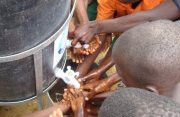A seven-year prolonged drought has intensified and the people of Kayafungo are suffering. Kayafungo is the poorest location in the third-poorest district in all of Kenya. Women usually walk up to two miles to fetch water from brown dams teeming with parasites. Now, during the dry season, a woman must walk almost four miles to collect a single five gallon bucket of water which she carries home on her head.
As of February this year, three people have been reported dead due to starvation. Food relief was trucked in by USAID, but the 2.2 pounds of corn flour per family is far from sufficient to assuage their hunger. The dropout rate in primary school is higher than ever because pupils stay home in search of food and water instead of attending class.
Student Movement for Real Change (SMRC) is committed to addressing this dangerous water situation. We had originally planned to build a water pipeline but technical constraints forced us to pursue other solutions, including roof rainwater catchment systems and dam construction.
To retain downpours during rainy season, we installed roof gutters and two 1,300 gallon tanks at Gogoraruhe Primary School, which was built by SMRC in December 2008. We also rehabilitated the roof rainwater catchment system at a nearby health clinic. However, this has not solved the daily lack of water that families face at home.
In November 2008, SMRC collected proposals from community groups. The proposals ranged from constructing a classroom to launching a chicken-rearing business. Four proposals outlined dam expansion projects as a way to alleviate the growing water crisis.
The area coordinator from the Coast Water Services Board (CWSB) visited the project site to determine the feasibility of our water-collection scheme and to propose a budget. He quoted a price of $1,000 for a professional survey and at least $60,000 to hire bulldozers for the digging.
With only $3,300 raised by SMRC volunteer Ted Couch and a desire for the money to go directly to the community and not to the pockets of the CWSB (where most funds tend to end up), we decided to hire the community itself for the excavation. Working with local people who were experienced in dam construction techniques, we arranged a three-day per week work schedule that lasted over a month.
To reinforce my commitment and inspire others, I spent the night before the project with a family in Kayafungo and woke early to dig. In the morning, when I arrived at the site, two hundred people were already hauling dirt.
Each person, or group of people if they had decided to work together, was paid about two dollars to clear a five-by-seven foot plot. With pick axes, hoes, and shovels we broke away at the hardened ground. Buckets of water were manually transported up the embankment. Men and women, balancing buckets on heads and shoulders, navigated the pathways and climbed the dam wall to dump their loads before returning again. For hours we worked in the hot sun.
I have never seen so many babies at a construction site. I watched as a woman dug dirt and hauled a bucket with a child strapped to her back. When she had cleared a large enough space, she put down a piece of fabric and let her child play with rocks while she continued to work.
People crowded around the project chairman's table on payday to present their government ID and stamp their thumbprint near their name. Most of the people in Kayafungo are illiterate and cannot make a signature. The sudden influx of money has spurred the creation of new businesses. Near the dam site, those not digging would cook meals and sell vegetables.
As construction neared an end, our lack of resources began to slow us down. But generous SMRC donors pledged to complete our endeavor. Even when funding dried up completely the community continued to work as volunteers, hauling giant buckets filled with dirt, day after day in the scorching sun.
Now we wait for rain.
Lily Muldoon is Project Director, Student Movement for Real Change.



